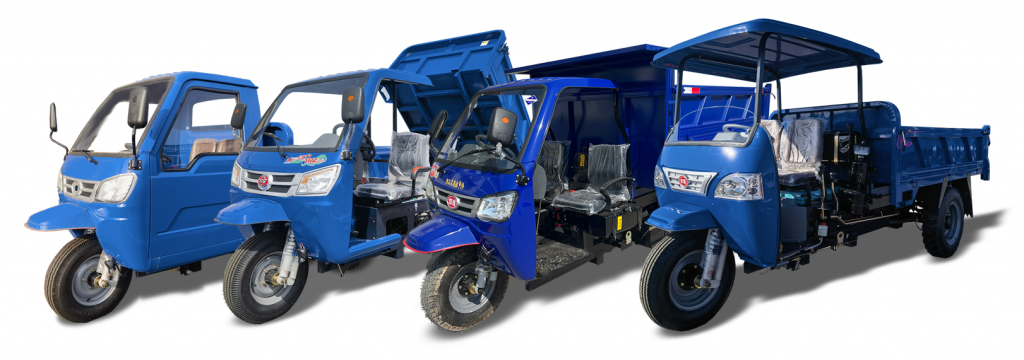The Historical Evolution of Diesel-Powered Tricycles: From Utility to Innovation
Diesel-powered tricycles, often overlooked in mainstream automotive history, have played a vital role in global mobility, particularly in developing economies. Combining rugged practicality with affordability, these three-wheeled workhorses have evolved from rudimentary cargo carriers to sophisticated machines. This article traces their journey through time, highlighting key technological and cultural milestones.
Early Origins: The Birth of a Niche (1900s–1940s)
The story of diesel tricycles begins with the convergence of two innovations:
Rudolf Diesel’s Engine: Patented in 1892, the diesel engine offered superior fuel efficiency and torque, ideal for heavy-duty applications.
Three-Wheeled Vehicle Designs: Early 20th-century experiments with motorized trikes, such as the 1904 Scripps-Booth Autoped, focused on urban mobility but were initially gasoline-powered.

During World War I and II, diesel engines gained traction in military logistics. Post-war, surplus engines and chassis were repurposed into improvised cargo trikes in Europe and Asia, laying the groundwork for commercial models.
The Rise of Practical Utility (1950s–1970s)
The 1950s marked the diesel tricycle’s transition from makeshift transport to organized production. Key developments included:
Agricultural Demand: In countries like India, China, and Southeast Asia, diesel trikes became indispensable for rural transport, hauling crops, livestock, and goods over rough terrain.
Industrial Simplicity: Manufacturers prioritized durability over comfort, using steel frames, air-cooled engines, and manual transmissions.
Government Support: Subsidies in nations like Thailand and the Philippines encouraged small-scale industries to adopt diesel trikes for local commerce.
Notable models included India’s Bajaj Auto cargo trikes and Japan’s Daihatsu Midget, though the latter was gasoline-powered, reflecting regional fuel preferences.
Global Expansion and Customization (1980s–2000s)
Diesel tricycles became cultural icons in emerging economies:
Asia’s “Three-Wheeler Revolution”: In the 1980s, China’s Shifeng Group and India’s Mahindra mass-produced diesel trikes tailored for farming and urban delivery.
Africa’s Adaptations: Modified trikes with extended cargo beds (e.g., Nigeria’s “Keke Marwa”) served as mini-trucks and passenger vehicles.
Technological Upgrades: Introduction of water-cooled engines, improved suspension, and hydraulic brakes enhanced reliability.
However, environmental concerns emerged. Dense cities like Manila and Jakarta grappled with noise and emissions from aging diesel fleets.
Modernization and Sustainability (2010s–Present)
The 21st century brought transformative shifts:
Emission Regulations: Stricter standards (e.g., Bharat Stage VI in India, China’s National VI) pushed manufacturers to adopt turbocharging, electronic fuel injection, and exhaust aftertreatment systems.
Hybrid and Electric Challengers: Electric trikes (e.g., China’s Niu Technologies) began competing, though diesel models retained dominance in heavy-load sectors.
Smart Features: GPS tracking, digital dashboards, and IoT-enabled diagnostics improved fleet management for logistics companies.
In 2020, India’s Piaggio APE Diesel and Pakistan’s Ravi Tricycle exemplified modernized designs with ergonomic cabins and reduced particulate emissions.

Cultural Impact and Economic Role
Beyond mechanics, diesel tricycles shaped societies:
Livelihoods: Millions rely on them for jobs in transport, waste collection, and street vending.
Urbanization: They filled gaps in public transit, connecting rural areas to cities.
Pop Culture: Films and literature (e.g., Philippine jeepney art) celebrated trikes as symbols of grassroots entrepreneurship.
Future Prospects: Challenges and Innovations
The diesel tricycle faces crossroads:
Green Transition: Biofuel compatibility (e.g., B20 biodiesel) and hybrid drivetrains may extend relevance.
Autonomous Tech: Pilot projects in Japan explore self-driving trikes for last-mile logistics.
Conclusion
From wartime ingenuity to modern sustainability efforts, diesel tricycles embody resilience and adaptation. While electrification looms, their legacy as enablers of economic mobility remains indelible. As engineers and policymakers reimagine urban transport, the diesel trike’s story reminds us that innovation often thrives in simplicity.
